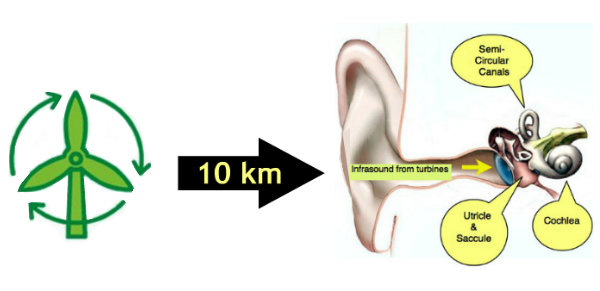Wind Turbine Syndrome documented out to 10 km (Australia)
Aug 12, 2012
 .
.
“Open letter to the Premier of South Australia” (7/18/12)
Dear Premier Weatherill:
I have written to you previously about continuing problems in my community from the Waterloo wind farm and about Frank Wang’s disputed survey of the 75 households within 5 km of the Waterloo wind farm.
You wrote to me that you had asked Dr Melissa Nursey-Bray to provide copies of her correspondence with me. I wonder what the outcome of that was?
In the end, since the results of Frank Wang’s survey were disputed by the University and he has decided not to release them, and I have been unable to interest any other independent organizations in repeating Frank’s survey, I decided to repeat his survey myself.
I am aware that this will be seen as biased, but as nobody else seems willing to investigate what is going on, I have undertaken my survey to show that there is a problem which needs to be taken seriously and investigated.
Because I personally know people who are genuinely affected at significant distances from the turbines, I extended the survey area to approximately 10 km from the wind farm.
My aim was to survey every household within 10 km, which was achieved by mailing and hand-delivering to letter boxes and Post Office boxes.
The results can be summarized as follows:
» 230 surveys were sent out in April 2012. 93 were returned. This was a 40% response rate.
» 46 respondents (49%) were negatively affected by some or all of the following: noise, shadow flicker, sleep deprivation, TV interference.
» Another 17 respondents said they noticed the above effects or that the effects varied with weather but they were not affected.
» The remaining 30 respondents said they were not affected. Some of these were turbine hosts.
I have attached my submission to the Select Committee on Wind Power in South Australia, which includes a summary of my survey of all households within a range of around 10 km from Waterloo Wind Farm (93/230 households responded).
I have also provided the results for 0-5 km (41/75 households responded).
At both of these distances, my results indicate that the current planning rules which allow wind farms to be built within 1 km of farmers’ homes are manifestly inadequate and not based on the physical realities of bigger and bigger turbines.
Noise pollution governance in South Australia is failing the people. The Environmental Protection Agency guidelines only require measuring of dBA, which is not the whole picture.
Whatever component of the sound spectrum is driving people out of their homes and depriving them of sleep needs to be measured and be part of the guidelines, as well.
The turbines at Waterloo are causing sleep deprivation many nights a week, up to 10 km away.
The percentages of households affected by electromagnetic interference, noise disturbance in the daytime and at night are far in excess of what is acceptable.
I am aware that the wind industry claims that smaller turbines have been in place in Europe for many years, but we are not dealing with the same scale or environment in the case of Waterloo Wind Farm.
Even with smaller turbines, local government authorities internationally are currently taking action against noise issues from wind developments to protect their communities. These include Palmerston North Council in New Zealand (see Palmerston North City Council v. New Zealand wind farms attachment and my summary notes). And in Falmouth, Massachusetts, USA (see Board of Health attachments).
When you have read my survey results, I ask you to please initiate further independent collaborative studies at Waterloo Wind Farm with a view to scientifically establishing what is happening there and determine more appropriate setback distances and noise monitoring for existing and proposed wind turbine developments.
I look forward to hearing from you on this urgent matter.
Mary Morris, Mid North Wind Farm Awareness
PO Box 188
EUDUNDA South Australia 5374
Ph 08 85811567
Mob 0438 066 634
Attachments:
Evaluation of Wind Farm Noise Policies in South Australia: Waterloo Case Study (see also here)
Waterloo Wind Farm Survey April 2012 – Select Committee
Falmouth Board of Health – Health Effects of Wind Turbines (also here)
Falmouth Board of Health request for health study (also here)
Waterloo Wind Farm Survey April 2012 – Select Committee
Palmerston North City Council v NZ Windfarms Ltd
Notes on Palmerston Nth Council v NZ Windfarms

Comment by Johannes Karl Marciniak on 09/03/2012 at 10:08 pm
WINDFARM REFUGEE JOHN MARCINIAK .I LIFED NEARLY 3 KS OUT FORM THE EVIL WEAPONS OF MASS DISTRUCTION, THEY NEARLY KILLED ME. NOW I LIVE NEARLY 20KS AWAY I/WE THE EFFECTED CAN FEEL THEM HERE DOWN THE VALLEY.HOW MANY OTHER PEOPLE WOULD THESE WEAPONS HAVE KILLED IF THEY HAD NOT MOVED ????
WERE DO WE MOVE TO WHEN THEY ,SOYSIOPATHIC INSANE POLLIES AND BUEROCRATS ARE ONLY INTERESTED IN MONEY AND POWER AND DO THERE MASTERS BIDING,. I SPOKE TO PERSON IN WATERLOO A DAY AGO HE IS SO BAD HE CAN NO LONGER GET HIS HEAD AROUND FILLING OUT THESE QUSTIONAIRSE , SO HE IS NOT PARTOF THE ABOVE NO. . HOW MANY OTHER PEOPLE ARE IN SAME BOAT???
Comment by Anonymous on 09/13/2012 at 9:02 am
Good God this is so terrible. It is surreal. We will look back some day and shake our heads at the sheer arrogance of the governments that allowed this to happen. Hopefully we will be able to tell our Grand kids how all over the world, we all joined this fight to save the world from this complete devestating boondoggle! The law suits will be a joke as the wind companies will be broke and the governments will change. Our leaders should be made to wear an electronic ankle bracelet so we can track their whereabouts and hunt them down to stand trial . . . just like the war criminals that they are.